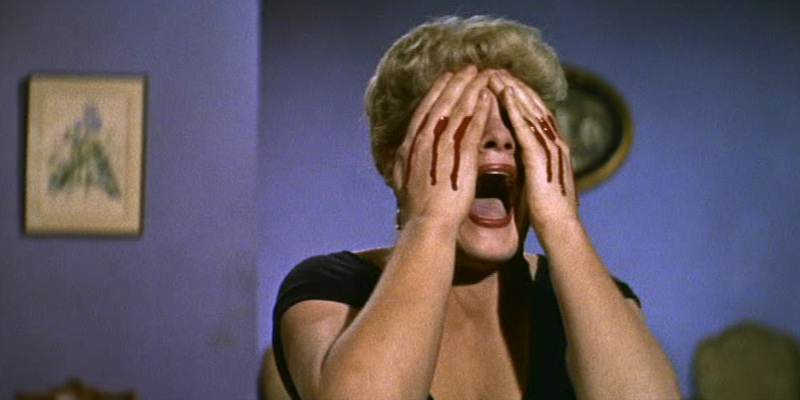
Review by
Eric Hillis
Directed by: Arthur Crabtree
Starring: Michael Gough, Shirley Anne Field, June Cunningham, Graham Curnow, Geoffrey Keen

Most horror historians will tell you the slasher genre began with the 1960
double whammy of
Psycho
and Peeping Tom. There's an argument to be made that it actually kicked off a year earlier
with director Arthur Crabtree's
Horrors of the Black Museum. If we're to define the slasher as a violent thriller in which the primary
focus is on the elaborate details of the kills, then this one certainly fits
the bill with a level of gruesomeness that must have really shocked its 1959
audience.
Horrors of the Black Museum employs what would become a
popular slasher staple, that of the killer using instruments of death
against his victims that form a distinct theme. It's an enduring trope that
you can see as recently as Eli Roth's
Thanksgiving. Here the connecting theme is that the murder weapons are inspired by
artifacts that reside in Scotland Yard's infamous Black Museum.

Crime journalist Edmond Bancroft (Michael Gough) scoffs at Scotland
Yard and is in the process of building his own rival Black Museum. He boasts
that while the Yard's museum is based on the failure of killers to get away
with their crimes, his features exhibits based on a constantly evolving
killing spree.
Like any good madman, Bancroft has an assistant, Rick (Graham Curnow), a young man whom he hypnotises and orders to carry out murders, which he
then writes about with a suspicious level of detail. Bancroft's doctor finds
it odd that the writer falls ill just before every murder in London, only to
make a swift recovery in their aftermath, but he's unable to put two and two
together (I'd definitely get a second opinion if this quack gave me a
diagnosis).

Despite its lurid title and plenty of shocking red Kensington gore on
display, Horrors of the Black Museum is a rather pedestrian
thriller with little of the distinctive charm of British horrors of the era.
While the killings are notable, the movie really lags as we wait to get to
the next murder. Crabtree was best known as a comedy director, but
Black Musuem is played straight when it could really use some
ghoulish humour to liven things up. Vincent Price was originally considered
for the role of Bancroft and he would have brought a wicked charisma that
Gough can't pull off. Gough is certainly convincing as a villain but
Bancroft is so one-dimensionally horrid that he's not very compelling as an
antagonist. The supporting cast is a mix of competent older British thesps
and incompetent young stars who struggle to deliver the most basic dialogue
in a believable fashion.
Thankfully the murder sequences save Black Museum from being
as dreary as a school trip to a pottery museum. Truth be told, the movie is
most famous for a certain prop, a pair of binoculars that take their user's
eyes out with a pair of sharp prongs that emerge when the focus is adjusted.
The device is utilised in the film's shocking opening sequence, and followed
up with a makeshift guillotine, an electric charge and various other
implements used to dispatch Bancroft's enemies. I imagine it was the focus
on the mechanics of murder rather than the film's limited aesthetic appeal
that compelled Martin Scorsese to have it inducted into New York's Museum of
Modern Art.

Producer Herman Cohen was best known for
I Was a Teenage Werewolf and
I Was a Teenage Frankenstein. There's an element of those films carried over here in the character of
Rick, who literally becomes a deformed monster when hypnotised by Bancroft.
A more interesting version of the story might have centred Rick and focussed
on his attempts to release himself from his master's grip, but the film only
decides to hone in on this aspect in the final 10 minutes. Rick's girlfriend
(a wooden Shirley Anne Field) is placed in peril but we haven't
gotten to know her well enough to care sufficiently about her plight.
In the US, the film was preceded by an introduction by hypnotist Emile
Franchele. Claiming the film had been shot in the revolutionary process of
"Hypno-Vista," Franchele gave cinemagoers a basic introduction to the
principals of hypnotism. The short is included as an extra on Studiocanal's
discs, but you might want to hold off watching it until after viewing the
film as Franchele's techniques might actually put you into a deep
sleep.

